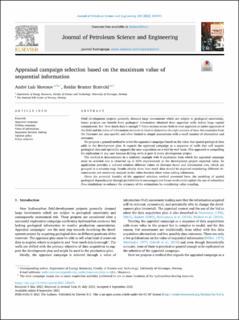| dc.contributor.author | Morosov, Andre Luis | |
| dc.contributor.author | Bratvold, Reidar Brumer | |
| dc.date.accessioned | 2021-09-20T10:47:51Z | |
| dc.date.available | 2021-09-20T10:47:51Z | |
| dc.date.created | 2021-09-16T03:23:49Z | |
| dc.date.issued | 2021-09 | |
| dc.identifier.citation | Morosov, A.L., Bratvold, A.B. (2021) Appraisal campaign selection based on the maximum value of sequential information. Journal of Petroleum Science and Engineering, 208, B, 109473. | en_US |
| dc.identifier.issn | 0920-4105 | |
| dc.identifier.uri | https://hdl.handle.net/11250/2779158 | |
| dc.description.abstract | Field development projects generally demand large investments which are subject to geological uncertainty, hence projects can benefit from geological information obtained from appraisal wells before large capital commitment. But “how much data is enough”? Value erosion occurs both in over-appraisal or under-appraisal of the field and the value of information rationale is ideal to determine the right amount of data. But examples from the literature are case-specific and often limited to simple assessments with a small number of alternatives and outcomes.
We propose a general method to select the appraisal campaigns based on the value that spatial geological data adds to the development plan. It regards the appraisal campaign as a sequence of wells that will acquire geological data and optimally supports the next acquisition on a well-by-well basis. This approach is compelling for replication in any case because drilling wells is part of every development project.
The method is demonstrated in a synthetic example with 8 candidates from which the appraisal campaign must be selected and is observed up to 65% improvement in the development project expected value. Its application provides a tailored solution different values of discount factor and information cost, which are grouped in a solution map. Results clearly show how much data should be acquired considering different circumstances and sensitivity analysis in the value function show value-adding robustness.
Given the potential benefits of the appraisal selection method presented here, the modeling of spatial geological dependencies through probabilities is encouraged and future work could explore the use of subsurface flow-simulations to enhance the accuracy of the estimations by considering value coupling. | en_US |
| dc.language.iso | eng | en_US |
| dc.publisher | Elsevier Ltd. | en_US |
| dc.rights | Navngivelse 4.0 Internasjonal | * |
| dc.rights.uri | http://creativecommons.org/licenses/by/4.0/deed.no | * |
| dc.subject | petroleumsgeologi | en_US |
| dc.title | Appraisal campaign selection based on the maximum value of sequential information | en_US |
| dc.type | Peer reviewed | en_US |
| dc.type | Journal article | en_US |
| dc.description.version | publishedVersion | en_US |
| dc.rights.holder | © 2021 The Authors | en_US |
| dc.subject.nsi | VDP::Teknologi: 500::Berg‑ og petroleumsfag: 510::Petroleumsteknologi: 512 | en_US |
| dc.source.volume | 208 | en_US |
| dc.source.journal | Journal of Petroleum Science and Engineering | en_US |
| dc.identifier.doi | 10.1016/j.petrol.2021.109473 | |
| dc.identifier.cristin | 1934734 | |
| dc.relation.project | Norges forskningsråd: 230303 | en_US |
| dc.source.articlenumber | 109473 | en_US |
| cristin.ispublished | true | |
| cristin.fulltext | original | |
| cristin.qualitycode | 2 | |

